by gabriel_sales | Mar 18, 2013
 One of the best things about the internet today is its ability to support a variety of mediums for the spread of information. The internet is not only filled with plain text, but also has film and sound. Presenting your message in an auditory or visual format can help your B2B online marketing efforts reach more people in a more entertaining way through Interactive Marketing.
One of the best things about the internet today is its ability to support a variety of mediums for the spread of information. The internet is not only filled with plain text, but also has film and sound. Presenting your message in an auditory or visual format can help your B2B online marketing efforts reach more people in a more entertaining way through Interactive Marketing.
One way you can present your message using sound is with the use of a podcast. A podcast is a short audio broadcast that you can stream or download (from your website or a third-party provider), comparable to an online radio show. You can use podcasts to spread the word about your company and its products and/or services.
Video marketing is pretty self-explanatory; you present your message through an online video. Despite how it may appear, YouTube is not just for videos with cuddly kittens. Your B2B company can sign up for a YouTube channel, and you can use it to keep your viewers updated on industry-related trends or present a how-to or demo video about one of your products or services. Many B2B companies have yet to catch on to the value of video marketing, so this is one place where you may be able to gain advantage over your competition.
Another way B2B companies can use audio and video in their digital interactive marketing strategy is a webinar. A webinar is what it sounds like, a seminar that takes place on the web. For B2B companies, webinars can be used a sales conference or online meeting, which can be effective for building brand awareness, educating new prospects and improving demand generation.
For more information on leveraging audio, video and interactive marketing as a B2B online interactive marketing strategy for sales, please reach out to us at Gabriel Sales. You can find our contact information here.
by gabriel_sales | Feb 6, 2013
 This blog offers some tips for your B2B marketing strategy regarding how to make your blog work for you.
This blog offers some tips for your B2B marketing strategy regarding how to make your blog work for you.
You may have heard by now that your B2B company needs to be blogging. As a B2B sales and marketing outsourcing company that specializes in demand generation, we would agree. But we only agree to the extent that you are blogging with purpose. Blogs for B2B sales can and should be leveraged in various ways to achieve your company’s sales goals.
To begin, if you have not looked at your blog strategy as a marketing strategy, we recommend you look through a sales/marketing lens. Several things to take into account are:
SEO—B2B companies often forget about their blog as a tool for improving SEO. Because Google and most other search engines now filter their results by relevancy, the more relevant you blog content is for your customers, the higher it will show up on search results pages. Our experience as a sales and marketing outsourcing company has also shown that aligning the input of your sales reps with your keyword research ensures you get the full value from inbound leads.
Thought Leadership—While some of the more traditional marketers may not agree, we believe your sales reps are a great source of content in terms of thought leadership. Your sales reps spend all day on the phone talking to customers, answering their questions and solving their problems. By drawing upon these conversations and turning them into blogs focused on answering FAQs and solving problems, you can establish your business as a thought leader within your industry.
Email Sign up—Every B2B sales companies’ blog should have a place to sign up/follow via email. This is the best and easiest way to leverage your blog for lead generation. The key to getting people to sign up for your blog is establishing yourself as a thought-leader and/or providing your prospects something of value.
Calls to Action—Leveraging your blog for lead generation can also be done using calls to action. Since your prospect has already shown interest in clicking on your blog, you should make it easy for them to reach out to you. All of your blog posts should include a highly visible place where they can contact someone on your sales team. Just be careful that your blog does not appear as one big advertisement for your company.
Recycling Old Content—Many companies do not take advantage of the long-shelf life of their sales and marketing content. Because of the way the Internet works today, content still capable of providing value becomes hidden from your prospects or disappears completely. A B2B blog is a great place to make use of this old content by providing links back to old posts in your newer ones. Another way to use old content for blog posts is to ask your sales reps for any independently created content they may have lying around.
If you would like to learn more about how a sales marketing company can help you improve your B2B marketing strategy for a fatter pipe and more closed revenue, please feel free to contact us for a free initial strategy conversation.
If you are having cultural issues between sales and marketing we suggest you check out B-to-B Demand Generation Requires Sales and Marketing Alignment. You can also checkout our Free White Paper on 10 Tips and What to Avoid to Sell Smarter and Faster.
by gabriel_sales | Jan 23, 2013
 Landing page design is all the rage for B2B demand generation tactics in 2013. However, having glitzy graphics or a colorful layout will only get you so far. What we have seen in our work as a B2B demand generation and sales and marketing outsourcing company is that the content of the page is much more important than what it looks like.
Landing page design is all the rage for B2B demand generation tactics in 2013. However, having glitzy graphics or a colorful layout will only get you so far. What we have seen in our work as a B2B demand generation and sales and marketing outsourcing company is that the content of the page is much more important than what it looks like.
This blog gives some simple tips on how to craft persuasive and successful landing pages. If this content is a little too basic for your needs we invite you to check out our B2B Demand Generation Blog Topic area or our B2B Demand Generation Knowledge Center.
Five tips for creating landing pages for B2B demand generation:
- One landing page is NOT enough—each product, service or campaign you have should have a landing page to match. Marketing automation tools like Pardot can simplify this process.
- Match the content to the keywords—the landing page should be directly related to the link your prospect clicked on to get there. Do not make your customers search for what they want.
- Make your goal obvious—decide what you want your potential customer to do on each landing page, and then make it easy for them to do so. The goal should almost always be B2B demand generation of sales qualified leads.
- Keep it simple and transparent—do not overwhelm your visitor with a lot of different options or complex language. For example, say something like, “If you fill out this form, then we will send you a white paper about a specific topic.”
- Use keywords for SEO—for search optimization, you cannot overuse keywords (the keyword for this page is B2B demand generation). Using the right keywords in the right places will result in an SEO lift for your entire site.
For more information on building effective landing pages or B2B demand generation tactics, please visit our blog titled “The Importance of Landing Pages” or contact Gabriel Sales directly. For a quick overview of how Gabriel Sales creates and integrated inbound and outbound machine CLICK HERE to view our How To Build a B2B demand generation engine. To schedule an appointment for a free pipeline velocity review from Gabriel Sales, please click here.
by Glen Springer | Nov 16, 2012
 The numbers are in and all the experts and your peers believe that 2013 is the year that content marketing is going to cross the chasm and become a requirement to compete and win. This article is a quick recap of several studies from the past six months. If you have not started integrating and embedding a content marketing process as a strategy to support your sales and lead generation effort yet, now is a good time to start. Here is some of the most recent data to consider:
The numbers are in and all the experts and your peers believe that 2013 is the year that content marketing is going to cross the chasm and become a requirement to compete and win. This article is a quick recap of several studies from the past six months. If you have not started integrating and embedding a content marketing process as a strategy to support your sales and lead generation effort yet, now is a good time to start. Here is some of the most recent data to consider:
Your Competition Has Committed to Content Marketing
A study of 440 B2B marketing professionals points to a commitment to content marketing with two-thirds of the respondents stating they will be either “very” or “fully” engaged in content marketing by next year. This represents a 100% increase (66% to 33%) over 2012 to 2013.
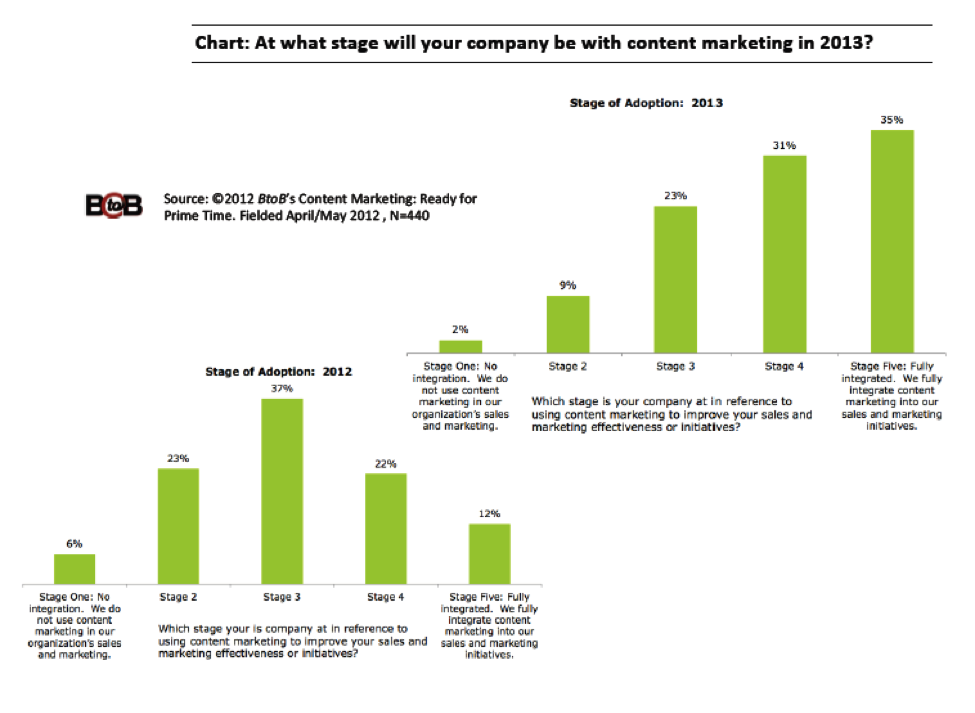 Content Marketing is Now the Number 1 Tactic for B2B Lead Generation
Content Marketing is Now the Number 1 Tactic for B2B Lead Generation
From the same study, according to marketing professionals surveyed, over 51% see content marketing as the most important tool for B2B lead generation.
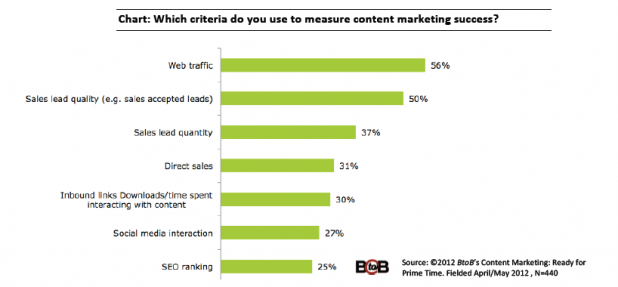
Content Helps Your Sales Team with Higher Quality Leads
What’s even more dramatic is the shift that we now see in marketers’ understanding that content is critical for helping them to improve the performance of their lead generation, now that a full 50% of lead generation specialists are embracing the use of content marketing to help generate better quality leads.
Content Marketing Challenges
Content marketing requires a commitment and, according to a Marketing Sherpa study earlier this year surveying early adopters and champions, the biggest challenges you will face if you have not yet embedded a content marketing practice into your organization are outlined in the chart below:
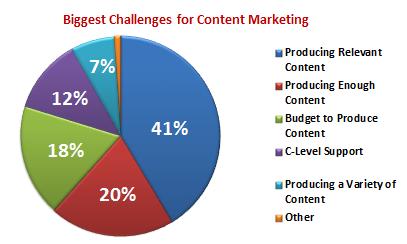
This is where an outsourced sales and marketing organization like Gabriel Sales can help. To learn more about how we use content marketing to help your organization improve its B2B lead generation, sales qualification and sales education process, feel free to check out our blog series: Digital Content to Automate your Sale, which is a crash course in integrating sales and marketing efforts. Also, check out our Quick video overview that explains “How to Build a Demand Gen Engine”. If you are ready to chat, request a quick review to see if we can help.
Additional Blogs in this Series:
Part 1 – Increasing Your B2B Sales Volume and Revenue – What’s Changed?
Part 2 – What Does Your B2B Sales and Marketing Culture Need to Look Like?
Part 3 – What Core Competencies do I Need From My Marketing and Lead Generation Team?
Part 4 – How Can Marketing Automation Improve My B2B Sales Performance?
Part 5 – Why is Content Marketing is Now Required for Quality B2B Lead Generation?
by Glen Springer | Apr 30, 2012
So now you that you have purchased a marketing automation platform you are ready to implement and it’s not as simple as you were led to believe. As an outsourced sales and marketing company we have already helped to implement several platforms (as well as implementing our own) and helped companies with several stalled implementations. Here are some best practices in marketing and sales automation because, as one vendor recently told us, ‘we can sell them the car but we can’t drive it for them’. Here are some basic tips and some best practices to help you avoid some headaches and to learn from our mistakes and success. If you have not checked out what these platforms can do here is a quick overview from Pardot 5 Minute Overview of Marketing Automation and this post will make a whole lot more sense.
Think about your Content in a Different Way – The whole point of a marketing automation platform is to drive more business in a more effective way. This starts with how you are speaking with your buyer. If your content is still all about your product – tech sheets, features and benefits etc. its -time to think about being customer centric rather than product centric.” Your drip campaigns will drive more business if you talk to your customers about their problems and their needs. You may need to look at the “voice” of your messages and refine your language a bit. As a starting point look at how may time you talk about “Our’ product, “our” team vs. “your” needs, “your” business and “your” customers. Stop being product centric and start being customer centric. Here is a series of blogs on how to shift your content approach and get sales and marketing on the same page.
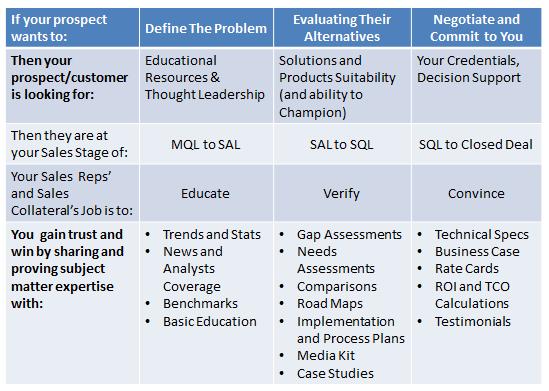
Organize your Content Ahead of Time. For a marketing automation platform to run effectively it helps to do two things with your content. First you should isolate all your webcasts, white papers, blogs, videos on individual website pages. This allows you to easily understand what your customer specifics needs are which in turn allows you to score your leads more effectively as you track their digital interest. Secondly, it really helps to also create landing pages that offers your customer content for all three stages of their buying cycle so you can track when your buyers are moving from educating themselves (kicking the tires) to being ready to buy (e.g looking at pricing or testimonials). Gabriel Sales has created an easy to use sales content management technology – Gabriel Sales Digital Base Camp™ that can help you do this in a matter of weeks. Below is an example of one of those lead scoring features.
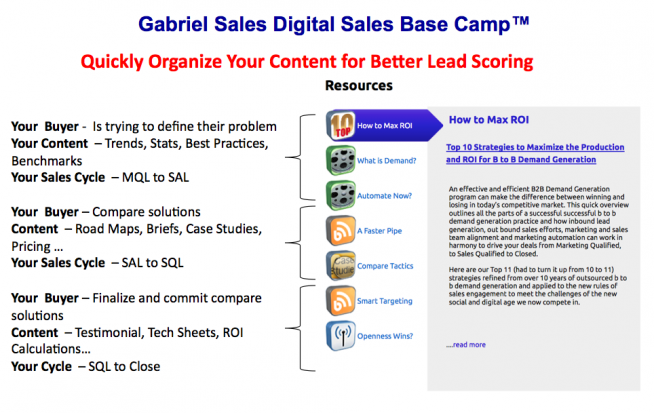
Involve Sales and Invest the Time Integrating with your CRM – What we have found is that even a basic integration can take an IT professional too much time. Most of the marketing automation platforms we have seen have huge volume of really cool features and bells and whistles so you can tend to over design before you know how you want to use them. Ultimately this is about empowering your sales team and recognizing your IT teams expertise is not sales. Probably one of the biggest bottle necks we have seen is that IT folks get proprietary and a project that they thought would take weeks can take a developer three months or more . The challenges are not with the system’s API or stability; they were with our client’s requirements, process definitions and prioritization. Like most development work that starts “easy” it quickly gets complex when they don’t understand the underlying business processes. Unfortunately as the time line expands it ends up being sales and marketing that are on the hook for results and not the developers. Salesforce.com has been the easiest integration for all the platforms we have seen.
Keep your Initial Drip Campaigns Simple. This is probably one of the biggest lessons we learned. When we first started we came up with a very complex IF/ then workflow so if they opened this piece of content on a topic area we would send them another piece of content on topic area B and then if they didn’t open that we would send them content Z. It was too much and just writing about it confuses me. What we found is about 80% of the value you are going to get from your initial drip campaigns is going to come from simply implementing them. It takes time to learn a new software and the biggest value the software provided initially is simply keeping your brand and solution in front of your buyers over time so your reps don’t have to. A simple five to seven touch campaign without any IF/then work flows was enough to get more deals flowing at less cost. Don’t frustrate yourself. You will quickly learn from your wins. If you are a smaller company, as a best practice, we recommend that you start by talking to your sales reps about their sales process and simply take that sales process map and create your initial drip campaigns for about three target markets.
Tap your vendors (and other vendors) knowledge centers – This industry is not that old. Eloqua, Pardot and Marketo (to name a few) all have fantastic knowledge centers that can teach you the basics of lead scoring and nurturing etc. Our vendor Pardot has been a huge help but we have also found both Marketo and Eloqua’s knowledge centers to be valuable as well. Obviously as an outsourced sales and marketing company we also recommend that you strongly consider working with an organization like ours. We have the advantage of having worked in the space across multiple enterprises so we have made a great deal of the mistakes already so you don’t need to.
We hope this blog has been helpful. Marketing Automation is a relatively new concept for most marketing teams and we have found that once you start to gain some momentum you will quickly realize that it’s clearly how business will be done for the next decade. We are just at the beginning of a new paradigm starting with marketing automation and then, as we are quickly discovering, if your marketing automation implementation is done correctly this will drift towards sales automation. Ultimately this will begin to drive more deals fast at less cost. We are experiencing some fantastic initial success reducing cost of sales percentages for both ourselves and our clients. The learning curve is exponential. So have fun.
If you have not checked out what these platforms can do here is a quick overview from Pardot 5 Minute Overview of Marketing Automation. If you have a stalled with your marketing automation implementation or if you would like to know more about best practices in marketing and sales automation, feel free to contact us for a quick consultative call.
by Glen Springer | Feb 3, 2012
 We are calling this a Top 10 demand generation strategies list, but as we went through the strategies, we felt the need to give your b to b demand gen amplifier one more notch and took it to 11. This blog post is a quick reference for your company to build a successful b to b demand generation strategies focused on improving your ROI statement.
We are calling this a Top 10 demand generation strategies list, but as we went through the strategies, we felt the need to give your b to b demand gen amplifier one more notch and took it to 11. This blog post is a quick reference for your company to build a successful b to b demand generation strategies focused on improving your ROI statement.
1. Don’t wait to follow up on leads. You spend $15K, $30K, $100K plus on a trade show. You spend money on inbound pay-per-click, or publishers etc. If the marketing department is in charge of sharing the leads they may score and then share with an internal team or an outside vendor. If the sales team is in charge they will often prioritize by gut. We understand the value of both approaches. You want to call the best prospects first. However, generally what occurs is that lag time of a few hours can turn into days and weeks. That lag time hurts especially if your leads are in a highly competitive industry (getting there first improves your closing % by as much a 100%), your sales cycle is 90 days or less (first 3 get short listed), or your leads are driven by search engine marketing (could be a “just in time” need). Many marketers we talk to will proudly say “we call on incoming leads within a week.” Guaranteed they have never done a study on the effects of that delay.
2. Make those extra calls. Don’t give up on leads after 1 or 2 calls if you don’t connect. This is especially challenging for sales reps that are not supported by a demand gen inside rep. A sales reps’ job is to close business. If they have deals moving this quarter they don’t always have the time to make that third or fourth call. As a b to b demand generation outsourced company and a sales outsourcing solution provider we have done countless studies that have shown that the 3rd, 4th and sometimes 5th attempt is where the payoff comes. This is especially true the more senior the decision maker. They are just tougher to reach.
3. Have an additional piece of content. Have a new offer after every call to keep the prospect engaged and give your rep “a reason to follow up” to ask them what they thought. Bottom line is that content keeps a deal moving without needing to get your senior talent on the phone to educate the prospect. It provides a reason for dialogue. It allows you to keep asking “what else are you curious about or what can I share to help you”. It allows you to talk about their needs while you share your position as well. Selling is about the customer not you and this allows you to kill two birds with one stone.
4. Lead with more than just a demo as your initial offer. As a sales outsourcing company we understand that clients want us to transact now but it doesn’t always work that way. Their strategy is often to get the prospect in that demo as quickly as possible and if the prospect is ready to do that great! However smart b to b demand generation requires that you also have an offer for prospects that aren’t ready to make that commitment. The prospect is not unintelligent. They know that getting into that demo starts them on the path towards committing to buy. They may not be ready to make that decision yet and they don’t want to waste your time or theirs, so give them a way to engage that is a bit softer and slower.
5. Educate but keep the costs down. We live in competitive times so many businesses’ marketing efforts focus on the product and ignore the value of educating their prospects so that they realize the value they are offered. To win deals and ensure you are receiving a top dollar for your product or service the customer needs to understand the value you are driving for their business. To explain that value the customer needs and wants understand that value. So you need to help your customer by helping your customers get what they want – which is fair, independent and “neutral” views that help them take informed and unbiased decisions. This is quick content to create especially for your senior sales executives if you can get them blogging. What is common sense for you as the expert, especially when it comes to competition and the “internal independent research” available, is often very valuable new information for you customer.
6. Don’t forget about your existing customers. They are the core of your business, without them you don’t exist. So the core of your business is that successful relationship. Keep building on that relationship and continue to share content with them to build even more trust. This will organically turn them into advocates. They tweet, they belong to Linked-In, Google . Don’t ask for them to do it. Just make it easy for them. Referrals work in new and unexpected ways so simply be surprised and especially grateful when they ask to contribute content for you.
7. Listen to your sales team and your prospects to generate your content strategy. In many cases, the sales team understands what the customer needs before the customer does. This is especially true if you have a disruptive solution moving into an existing market or an existing solution moving into new markets. Creating a great deal of content quickly is not tough. If you listen to your prospects objections and the same questions or concerns come up several times turn it into a blog post. You can than take that sales conversation to address other prospects’ needs and, even more importantly to your b to b demand generation effort, take that “sales conversation” into the social media conversation.
8. Know your the inflection point for your ROI statement when implementing a Marketing Automation Platform and Nurturing program. A platform (as an outsourced sales company we recommend Pardot) cost $16K. A 3 series webinar will cost you roughly $6K-$10K in house or external. Basic blog content creation will cost about $12K. And planning, database integration and implementation can range from$12K to $24K. So all in you are looking at $72K if you are starting from scratch. If you are following the best practices laid out above or you have implemented a sales outsourcing solution, or b to b demand generation solution with Gabriel Sales, you will already have a great deal of the content planning you need so an implementation is roughly $24K-$36K. You can do the math from there (we have a back of the envelope chart below to help). If your average deal size is $100K the ability to track digital content and the time savings alone for the senior rep makes it an easy decision to pull the trigger. For smaller and shorter sales cycles it really comes down to how many leads you have in your database because countless studies have shown that if your product has legs you can expect to convert at least 1% to 3% of the leads that were initially just curious:
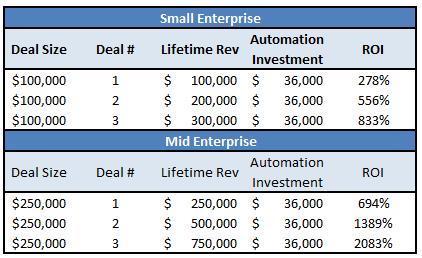
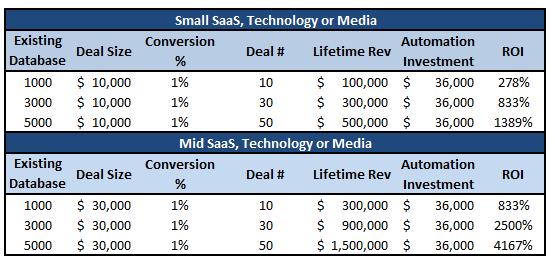
9. Create digital landing pages for your sales reps to use that are customer centric.. As your content grows create a resource page that is customer centric. Design them to help the customer make decisions. Give them educational content, evaluation content and verification content in one easy to find area. Combine your general educational content (70%) with some vertical specific content (30%) so you are speaking directly to that particular need or pain area. Don’t make the content just about you make it about them; around the needs of your customer by decision maker type. Make it easy for your customers to find what they need, and almost as important, make your brochure dynamic so you are not wasting your sales reps valuable phone time keeping up with new additions to your marketing mix. Keep them focused on selling. Gabriel Sales has developed a simple to implement landing page engine that can be up and running for you in a matter of weeks to jump start this process.
10. Re-purpose the digital land page to generate inbound traffic and remove barriers to engaging. The “sales” conversation, the digital conversation and the “social media” conversation are the same conversation. The objections your reps hear and address are the same that customers who haven’t found you yet have. Make it easy for them to find you and maximize your sales content investment by driving traffic to that page with long tail SEO and PPC campaigns that keep your costs down. Keep the language on the page focused on the customer using the language of “your” and “you” not “we” and “us”. And finally keep the requirements of your form down to the basics – customer name andemail address. Keep any other fields optional.
11. Lead Generation Reps and Demand Generation Reps have different tasks and need different skills sets. The new rules of sales engagement require your demand generation reps and your sales reps to have different skill sets. Lead gen reps are often calling cold. Their scripts are different, their call volume is different and their personality is different from what is required by reps moving inbound leads forward. Demand gen reps are there to facilitate. Lead gen reps are there to put leads in the pipe. Be conscious of the difference and either train your lead gen reps in the new rules of sales engagement (so they are not creepy or overly assertive) or hire a different rep to move deals from Marketing Qualified to Sales Qualified.
For a full overview of why we feel it makes strategic and executional sense to have your sales team involved in your sales content marketing strategy, strategic approaches to team integration and a road map for fluid communication, and demand generation strategies we invite you to read the following blogs:
Top B2B Demand Generation Requires Sales Content Marketing
Top B to B Demand Generation Requires Sales and Marketing Alignment
5 Steps to Launch or Turn Around a B to B Demand Gen Team
If you have any questions about how Gabriel Sales can help you pull together more effective demand generation strategies that are driven by your ROI statement, whether you are mid cycle or building a new effort, feel free to CONTACT US.
 One of the best things about the internet today is its ability to support a variety of mediums for the spread of information. The internet is not only filled with plain text, but also has film and sound. Presenting your message in an auditory or visual format can help your B2B online marketing efforts reach more people in a more entertaining way through Interactive Marketing.
One of the best things about the internet today is its ability to support a variety of mediums for the spread of information. The internet is not only filled with plain text, but also has film and sound. Presenting your message in an auditory or visual format can help your B2B online marketing efforts reach more people in a more entertaining way through Interactive Marketing.
 This blog offers some tips for your B2B marketing strategy regarding how to make your blog work for you.
This blog offers some tips for your B2B marketing strategy regarding how to make your blog work for you. Landing page design is all the rage for B2B demand generation tactics in 2013. However, having glitzy graphics or a colorful layout will only get you so far. What we have seen in our work as a B2B demand generation and sales and marketing outsourcing company is that the content of the page is much more important than what it looks like.
Landing page design is all the rage for B2B demand generation tactics in 2013. However, having glitzy graphics or a colorful layout will only get you so far. What we have seen in our work as a B2B demand generation and sales and marketing outsourcing company is that the content of the page is much more important than what it looks like. The numbers are in and all the experts and your peers believe that 2013 is the year that content marketing is going to cross the chasm and become a requirement to compete and win. This article is a quick recap of several studies from the past six months. If you have not started integrating and embedding a content marketing process as a strategy to support your sales and lead generation effort yet, now is a good time to start. Here is some of the most recent data to consider:
The numbers are in and all the experts and your peers believe that 2013 is the year that content marketing is going to cross the chasm and become a requirement to compete and win. This article is a quick recap of several studies from the past six months. If you have not started integrating and embedding a content marketing process as a strategy to support your sales and lead generation effort yet, now is a good time to start. Here is some of the most recent data to consider: Content Marketing is Now the Number 1 Tactic for B2B Lead Generation
Content Marketing is Now the Number 1 Tactic for B2B Lead Generation



 We are calling this a Top 10 demand generation strategies list, but as we went through the strategies, we felt the need to give your b to b demand gen amplifier one more notch and took it to 11. This blog post is a quick reference for your company to build a successful b to b demand generation strategies focused on improving your ROI statement.
We are calling this a Top 10 demand generation strategies list, but as we went through the strategies, we felt the need to give your b to b demand gen amplifier one more notch and took it to 11. This blog post is a quick reference for your company to build a successful b to b demand generation strategies focused on improving your ROI statement.

